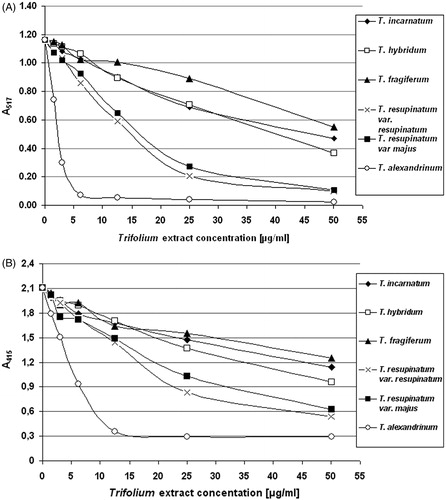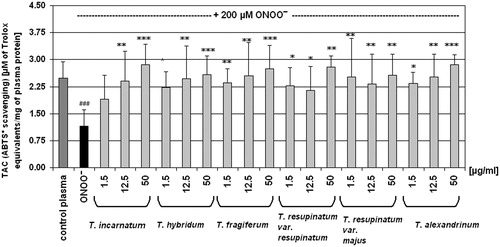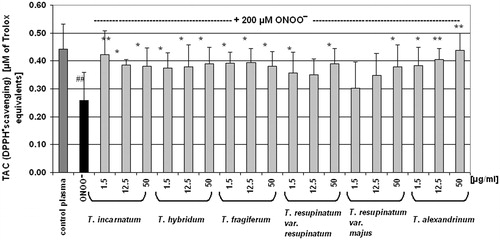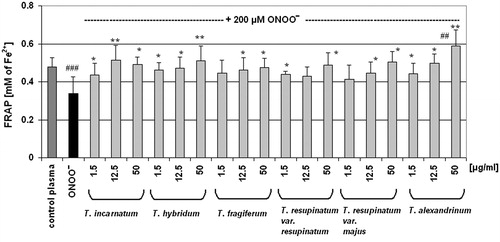Figures & data
Table 1. Phytochemical composition of the investigated Trifolium extracts (phenolic fractions, prepared from aerial parts of six Trifolium species).
Figure 1. Comparison of the reduction of DPPH• (panel A) and ABTS• (panel B) radicals by plant extracts, derived from six different Trifolium species. Free radical scavenging activity of the examined extracts was recorded as the absorbance (mOD) after 30 (for DPPH•) and 6 min (for ABTS•) of incubation. The figure is a graphical illustration of the observed effects and includes mean values of a measurement performed in triplicate.

Table 2. Comparison of the ferric reducing ability of the examined Trifolium extracts. The ferric reducing ability of clover extracts was measured at the final concentration range of 1.5–50 µg/ml and expressed as mM of Fe2+. The table includes mean values ± SD of a measurement done in triplicate.
Figure 2. Effect of Trifolium-derived extracts on total antioxidant capacity of blood plasma measured in the ABTS• assay. Antioxidant capacity of human plasma (control and exposed to 200 μM peroxynitrite) was determined spectrophotometrically by the ABTS• radical decolourization, and expressed as Trolox equivalents. Results are presented as means ± SD of five independent experiments: ###p < 0.001 for ONOO−-treated plasma (with or without extracts) versus control plasma, and *p < 0.05, **p < 0.01, ***p < 0.001 for plasma treated with ONOO− in the presence of extracts versus plasma treated with ONOO− in the absence of extracts.

Figure 3. Effect of Trifolium-derived extracts on total antioxidant capacity of blood plasma determined in the DPPH• reduction assays. Antioxidant capacity of control samples and plasma exposed to 200 μM peroxynitrite was determined spectrophotometrically by the DPPH• radical reduction (decolourization), and expressed as Trolox equivalents. Results are presented as means ± SD of six independent experiments: ##p < 0.01 for plasma samples treated with ONOO− (in the presence or absence of the extracts) versus control plasma, and *p < 0.05, **p < 0.01 for plasma treated with ONOO− the presence of extracts versus plasma treated with ONOO− in the absence of the examined extracts.

Figure 4. Effect of Trifolium-derived extracts on ferric reducing ability of plasma (the FRAP assay). The ability of blood plasma (control and exposed to 200 μM ONOO−) to reduce ferric ion to the ferrous ion was measured spectrophotometrically. Results (Fe2+ equivalents) are shown as means ± SD of six independent experiments: ##p < 0.01, ###p < 0.001 for ONOO−-treated plasma (with or without extracts) versus control plasma, and *p < 0.05, **p < 0.01 for plasma treated with ONOO− in the presence of extracts versus plasma treated with ONOO− in the absence of extracts.

